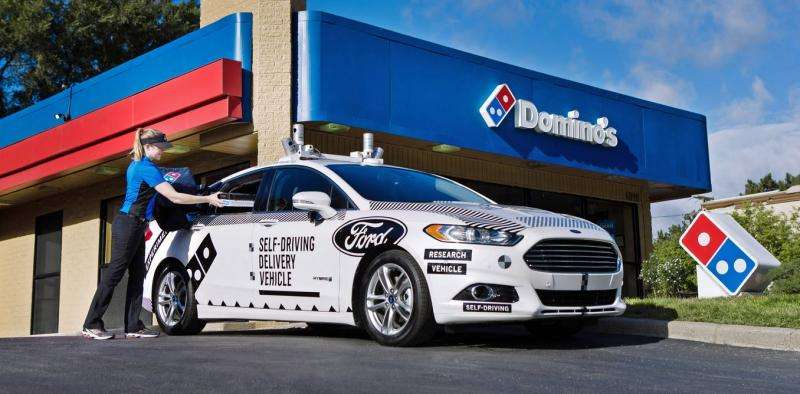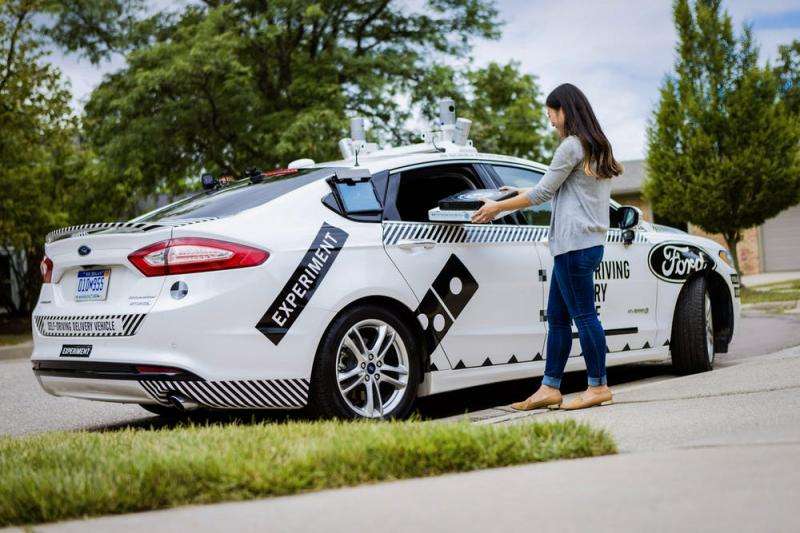Pizza delivery by robot cars has arrived with big questions

People in Ann Arbor, Mich., are experiencing home food-delivery without a driver.
Domino's Pizza and Ford have paired up in a pilot project that will look at how humans interact with driverless food-delivery cars. Ann Arbor is home to thousands of students, an age group not likely to view this new technology with suspicion. But it could turn into a fascinating social experiment for the food industry.
Customers ordering through Domino's will be able to track their delivery in real time by using a downloadable app on their smartphones. They receive a text message that gives them a four-digit code to use once the car arrives.
But it's the final portion of the drive that could prove unpredictable for Domino's. The driverless delivery vehicle could end up in the driveway, or near the curb. Customers may not want to go out to the car if it's raining or snowing. Domino's USA president Russell Weiner says these challenges are a major part of the experiment.
"We're interested to learn what people think about this type of delivery," he said in a recent statement. "The majority of our questions are about the last 50 feet of the delivery experience."
No tipping attractive to students
Human behaviour can be difficult to predict at the best of times, especially when dealing with food. This will be the first time a food service or retail company has used driverless cars to interact with actual consumers.
The experience will certainly offer convenience for customers in a variety of ways. With the app, expectations will be managed, and quality of service —Domino's key strategic focus—will be more consistent.
That's because delivery times will be streamlined, fewer pizzas will be damaged in handling mishaps and the customer won't have to deal with tips—at least not for now. No tipping will reduce price points, making delivered pizzas more affordable. For cash-strapped students, that's key.
For Domino's, the business case for a driverless fleet is unquestionably strong. Lower insurance costs, lower fuel consumption, consistent delivery times, no thefts, controllable temperatures to keep food safe for customers so therefore less waste—the list goes on.
Domino's delivers more than a billion pizzas annually, and has more than 100,000 drivers. Running a driverless fleet could save the company millions.
Embracing the concept of home food deliveries without having to hire drivers cannot come soon enough for the food service industry, which is looking for ways to increase revenue beyond their regular foot traffic.
Restaurant operators won't need to deal with the headache of hiring the right people for delivery, and delivery is an important means of expanding the brand outside their facilities.

Home delivery can be dicey
Most of us who have ordered home-delivered food have had mixed experiences.
Some drivers make convicted felons look like choir boys, causing customers to be hesitant about the food. But home delivery is no walk in the park for the drivers, either.
Drivers in the U.S. have told of finding themselves in unbelievably awkward situations, including being tipped with weed, being asked to eat with the customer to offer company, showing up during domestic disputes and being greeted by a naked customer as the front door opens.
There's an endless list of unpleasant scenarios that would discourage anyone from contemplating home food delivery as a full-time job or even part-time job.
A humanless home food delivery experience, on the other hand, also offers a unique perspective on the market currency of convenience.
For years, price has been king. In study after study, price has trumped any other feature consumers were looking for in food service.
Consumers crave convenience and privacy
Younger generations, however, have a different take on convenience. Price remains a significant factor for higher revenues of course, but the constant quest for more convenience on both sides of the food continuum is now reaching the point of obsession.
Getting rid of delivery personnel is now a realistic approach. With driverless home food delivery, one could potentially get food delivered without seeing a single human being—a frightening thought for some, a reassuring one for others.
In the future, consumers could binge on their favourite junk food several times a week without the embarrassment of seeing the same delivery person.
No matter how you look at it, Domino's and Ford are onto something. After all, driverless technologies are consistent with what Domino's is all about.
The company has been successful over the years with its mastery of home delivery. Joining forces with Ford could make the company even more efficient.
Nonetheless not all of us needs Domino's to get our food fix. Divorcing the human aspect from food is simply impossible for many food service companies—thousands of them, in fact. And thank goodness for that.
Provided by The Conversation
This article was originally published on The Conversation. Read the original article.![]()



















